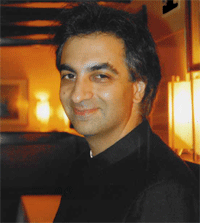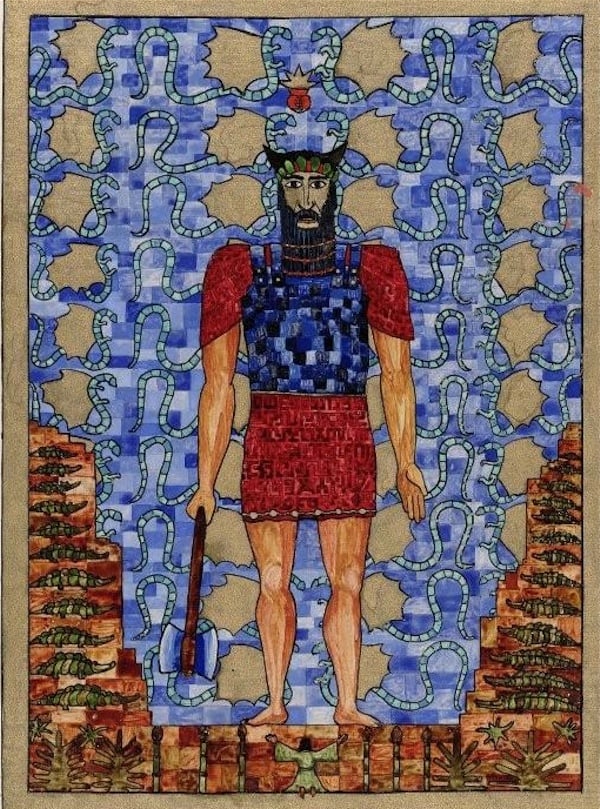The long-awaited publication of C.G. Jung’s Red Book is causing ripples in the world of psychology. Notwithstanding its enormous folio size and its hefty price tag, the book is already in its third printing. I put six questions to leading Jung scholar Sonu Shamdasani, Philemon Professor of Jung History at the Wellcome Trust Centre for the History of Medicine at University College London, who took the lead in editing the book and translated it from German, together with Mark Kyburz and John Peck.
1. The technical side of this book is fascinating: it is done on folio-sized sheets covered with calligraphy in several different chancery styles, and it is illuminated with captivating images in vivid colors, sometimes using gold-leaf. Did Jung physically execute this book all by himself? What works did he take as models?

Jung did indeed produce the work by himself. In the red leather folio volume, titled Liber Novus (“New Book”), he painstakingly transcribed the manuscript into a calligraphic script, headed with a table of abbreviations, and illustrated it with historiated initials, ornamental borders, and paintings. The paintings initially represent scenes depicted in the text. At a later stage, the paintings become more symbolic, relating to fantasies in his Black Books and representing further elaborations of his private cosmology. The work was clearly modelled after illuminated manuscripts from the Middle Ages, which I presume he would have been familiar with since his student days in Basel, though it is not clear if there was any particular work which he took as a model. The strongest resemblance is to the illuminated works of William Blake, which Jung was familiar with, though it is not clear when he first encountered them.
2. The scripts used seem to follow manuscripts from the fifteenth and sixteenth centuries—the Age of Faith is coming to an end, and the Renaissance is unfolding—and with it, the crisis of scientific method. Is that coincidental, or does it tell us something about Jung’s purpose in the book?
I don’t think that this is accidental. Towards the end of the second of three parts of the work, entitled Liber Secundus, Jung wrote: “I must catch up with a piece of the Middle Ages—within myself. We have only finished the Middle Ages of—others. I must begin early, in that period when the hermits died out.” The psychological history of humanity, as Jung saw it, lived on in the soul. In his view, the secular conflict that broke out at the beginning of sixteenth century had consequences that the Western was still grappling with, and had led to a separation of natural science and religion, which he saw his psychology as attempting to resolve. Consequently, after working on Liber Novus, Jung spent the remaining decades of his life studying the psychology of Western alchemy, arguing that it formed a counterpart to his psychology of the individuation process.
3. Jung frequently writes in the first person. We often discover, however, that the speaker is not Jung but another voice he is channeling. Students of Jung have seen this in other works, like the Seven Sermons, and it has fueled a good deal of criticism of Jung for his departure from accepted scientific method. How do you understand the function of this voice as it appears in the Red Book?
I think the term “channeling” is misleading in this context. What the text presents is a series of fantasies in which dramatic dialogues occur. Jung enters into discussion with the figures that emerge, and then attempts to draw lessons from their exchange. He viewed these characters as different aspects of his personality. The text describes his attempt to recognise and come to terms with these aspects through differentiating the voices, and eventually to integrate them.
Initially, this exercise was an attempt to study what in 1912 he had described as fantasy or undirected thinking, in contrast to directed thinking. At this time in psychology, self-experimentation was widespread, and introspection was one of the most common methods, though coming under increasing contestation. So in this regard, there was no major departure from the self-investigative procedures prevalent in psychology. At the same time, Jung certainly didn’t envisage the resulting work to be scientific: I think it could best be described as a work of psychology cast in a literary and prophetic form.
4. As you have noted, the publication of the Red Book will show the world a new side of Jung’s personality, and one that he apparently intended to show publicly, although his family resisted this decision. What indicators do you have for the claim that Jung expected the Red Book to be published? Why was his family reluctant?
To begin with, one must clearly differentiate Jung’s Black Books, in which he initially wrote his fantasies together with reflections on his mental states, from Liber Novus. The former were records of a self-experiment, while the latter drew in part on these materials to compose a literary and pictorial work. The address “my friends” appears in the book as a refrain. After composing a handwritten manuscript, Jung had it typed and edited it. One manuscript contains editorial suggestions from a colleague. He then transcribed it into the red leather folio volume, again revising the material once more. In 1924, he had this version transcribed once more. Sometime in the mid-1920s, he went back to the earlier draft, and once more made extensive revisions to it. During this period he had extensive discussions with Cary Baynes and Wolfgang Stockmayer concerning publishing it, and the form it should take. Such editorial activity doesn’t make any sense unless Jung was seriously considering publishing it. Although he eventually decided not to publish it during his lifetime, the unfinished epilogue he added to it clearly indicates that he expected it to be read by others. In this, he wrote:
I worked on this book for 16 years. My acquaintance with alchemy in 1930 took me away from it. The beginning of the end came in 1928, when Wilhelm sent me the text of the “Golden Flower,” an alchemical treatise. There the contents of this book found their way into actuality and I could no longer continue working on it. To the superficial observer, it will appear like madness. It would also have developed into one, had I not been able to absorb the overpowering force of the original experiences. With the help of alchemy, I could finally arrange them into a whole. I always knew that these experiences contained something precious, and therefore I knew of nothing better than to write them down in a “precious,” that is to say costly book and to paint the images that emerged through reliving it all—as well as I could. I knew how frightfully inadequate this undertaking was, but despite much work and many distractions I remained true to it, even if another possibility never …
In his will, the work was left to the keeping of his family, with no stipulations. However, he also made several verbal statements suggesting that it be donated to an archive and made available for study after a certain number of years. Up till the mid-nineties, the family had been engaged in supporting the publication of his Collected Works in German. It was only as that was nearing completion that the question of what to do with his extensive unpublished manuscripts seriously arose. When I began discussing the work with them in 1997, it had not been closely studied or seriously considered by living members of the family.
When it was discussed, it became clear that Jung had given copies of it to close associates, and that it was not a private, intimate diary, but a work conceived for publication, which formed the bedrock of his subsequent Collected Works, whose genesis couldn’t be fully grasped without studying it.
5. How do you expect publication of the Red Book to affect Jung’s image in the world in the coming years?

I find it easier to foresee the situation, say, in ten years time than in the immediate aftermath of the publication. At that time, the publication will be seen to mark a caesura comparable to the effect of the publication of the Nag Hammadi library on the study of Gnosticism – finally, one is in the position to study the genesis of Jung’s work and what took place in him during this critical period, on the basis of primary documents rather than gossip, speculation, and fantasy. It provides a unparalleled window into how Jung fused his fantasies with his scholarship and attempted to form a science of psychology. One can trace the steps from Jung’s experimentation with his fantasies and his elaborations and reflections on them, through his attempt to forge general principles and to confirm these principles in his work with his patients, and ultimately, in comparative historical research. Works written on Jung will be categorised in terms of a before and after, and ranked accordingly. Only on this basis can biographies of Jung begin to be written. As to the immediate aftermath, commentators are likely to find their preconceptions confirmed therein.

6. One of the striking images appears on folio 36 at the end of Chapter 6, “The Remains of Earlier Temples.” Jung’s marginal notation says it was painted around Christmas 1915. How does this dramatic image relate to the text, and how do you interpret it in the context of Jungian thought?
This is a portrait of Izdubar. Izdubar was an early name given the figure now known as Gilgamesh, based on a mistranscription. It resembles an illustration of him in Wilhelm Roscher’s Ausführliches Lexikon der griechischen und römischen Mythologie. Jung discussed the Gilgamesh epic in 1912 in Transformations and Symbols of the Libido, using the corrected form. His use of the older form here indicates that the figure is related to, but not identical to the figure in the epic. Jung encounters Izdubar in a fantasy. Jung says that he comes from the West, and tells Izdubar about the setting of the sun, the roundness of the earth, and the emptiness of space. Izdubar wants to know where he gets his knowledge from, and whether there is an immortal land where the sun goes for rebirth. Jung says he comes from a world where this is science. Izdubar is aghast to learn that we can never reach the sun and that he can never attain immortality, and collapses, poisoned by this science. Izdubar wonders if there are two kinds of truth. Jung says that their truth comes from outer things, whilst the truth of Izdubar’s priests comes from inner things. Jung makes a fire with a match and shows him his clock. Izdubar is astonished. However, Jung tells him that Western science has not found a means against death. Izdubar wonders how Jung lives with this poisonous science. Jung says that they have got used to it, and have had to swallow the poison of science. Izdubar asks if they have Gods. Jung says, no, just the words. Izdubar says that they also do not see the Gods. Jung says that science has taken faith from them. Jung says he can’t bare this well, which is why he has gone to the East, to seek the light that they lack. Jung longs for Izdubar’s truth. Izdubar tells him to be careful, as he could be blinded.
In terms of Jung’s thought, this scene stages the encounter between the ancient and the modern, the conflict between the truths of science and the truths of myth and religion, which he hoped to reconcile in the form of his psychology.


